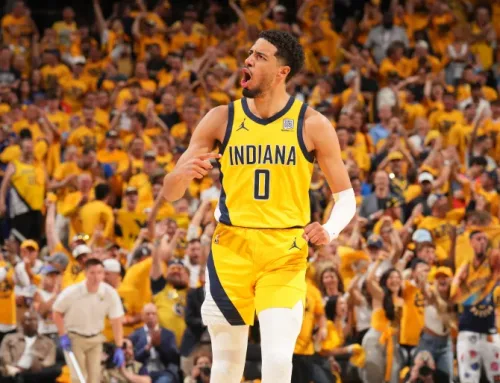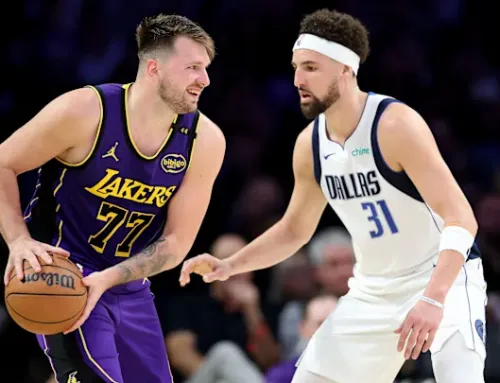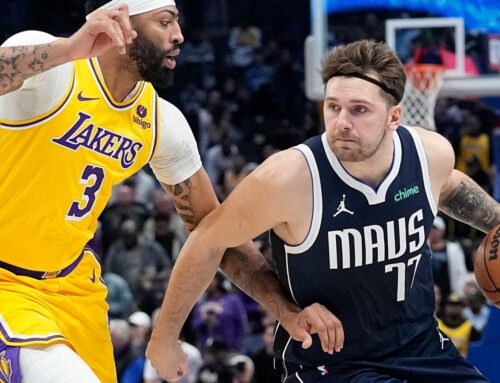First Round Observations
By: Avi Tyagi
Within the first round, many teams right out of the gate, will present their initial favorite strategies. Some of these might not work, but oftentimes, it can be informative of the team’s chances. Teams that initially struggle against certain lineups or styles may face even more difficult versions of those same problems later in the playoffs if they advance. Therefore, these are just some notes to keep in mind as the series progress.
How do lineups shake out?
Most teams enter these playoffs with question marks about the size of their playoff rotations, but most have provided clear indications about their starting lineups or closing lineups. 3 teams, however, have major question marks on that front.
Warriors: Welcome to the Poole Party
This one will be short. The title summarizes it. Poole is a versatile scorer, is capable of playing on and off-ball, and, secretly, is a decent team defender when he’s not fouling. He’s typically solid at keeping his matchup and the ball within his sight lines so as to break on passes to start transition attacks, and at the very least, avoid getting back-cut. Against Denver, in particular, that’s a plus. Will that be enough to ensure he earns 30-33 minutes a game as the rotation tightens? Aside from Steph, he is their only other self-creating option who can also open windows for others. A lineup with two options who can both divert the attention of defenses with constant movement and distribute out of the pick and roll exponentially increases the Warriors’ offensive upside. Will a full lineup with Steph back relegate Poole once more to ball handling only with bench units sometimes? They love running offense through Draymond and Iguodala, will their usage drop to accommodate the 3-guard lineups, and if so, what would that entail for their offensive effectiveness? Will it be Klay? Just a reminder, Poole has been averaging 25 a night since March with exceptional efficiency (a 64% true shooting figure!!!), often functioning as the primary option regardless of the surrounding cast. They have an immense amount of offensive talent, but they need to quickly determine how they plan to stagger lineups to maximize their shot-making potential.
Heat: Who’s the 5th starter? What’s their crunch time plan?
Herro is a great 6th-man spark-plug. However, he’s also a frequent release valve that opposing offenses search for to generate easier opportunities for themselves. Within closing lineups, the Heat may need to rely on Herro, simply for shot creation and that in itself creates questions about the viability of their half court offense. With the starting unit however, there are a few candidates to potentially grab a primary chunk of minutes. Will be Herro? Will Duncan Robinson emerge once again? Aside from those 2, there are 2 other sneaky candidates. The more obvious one is Max Strus. He’s more than happy to be the team’s lead archer, although not quite as dynamic without the ball as Robinson is. Of the two though, Strus is a marginal improvement defensively, by virtue of being less prone to fouling and being slightly better at containing opposing drivers. On a small volume of 85 possessions as the primary defender in isolation, Robinson has allowed 105 points, at the 8th percentile league-wide. By contrast, Strus has only allowed 71 points on 78 possessions, around a league-average mark. The most fun option to start may be Caleb Martin. Positionally sound, versatile, attentive against opposing cutters, solid in isolation, Martin is a fantastic defender. He can actually create for himself occasionally through a nice dribble-drive game against closeouts. The conundrum with starting him may be the redundancy of skillsets with Jimmy and Tucker. Martin can make 3s, but he’s not a high-volume option. Starting Martin would be a signal that the Heat are willing to go all in on their strengths (an amazing versatile defense with a variety of different drive and dish options) while relying on their bench almost entirely for certain aspects (namely any semblance of credible spacers). Would that work? I’m not sure. Would that somehow be a better option in crunch time? I’m not sure of that either.
Bucks: Wes Matthews right?
The Bucks are commonly earmarked as the favorite out east. Much of that is due to their established pedigree, and due to massive improvements from Jrue and Giannis. That duo may just be the best two-way tandem in the league, due to improved self-generated pullup shooting (3s for Jrue, mid-rangers for Giannis). However, there have been massive changes across the rest of the roster. When it reached game 7, the Bucks trusted only 7 options: the big 3, Brook, Connaughton, Tucker, and selective minutes for Forbes. Is Brook ready for that minute total again in the later rounds? Can the Portis-crowds-ballhandlers-up-top defense substitute in for a few minutes now? Most importantly, who takes the Forbes role and who gets the PJ minutes? Allen is a likely candidate for the Forbes slot but he provides a different skillset. The Forbes role, in theory, is meant to cloud the picture for the defense by activating an excellent movement shooter off the bench for 10 minutes a game to run handoffs and fling shots off of screens. Allen has proven to be far more of a stationary option and perhaps that’s enough now. Just mentioning in anyways. The biggest question is Who fills the Tucker role? The easiest answer seems to be Wes Matthews. In most matchups, if Jrue needs to relax on the defensive end to focus on his offensive responsibilities, it’s Wes’ time to shine. He’s secretly been a solid point-of-attack defender the past few years. He’s a more dynamic offensive player than PJ, so that helps his case. Is that what the Bucks need? Tucker’s elite strengths are his matchup versatility, his specific capacity to matchup against big wings so that Giannis and Middleton do not have to, and his elite corner 3-point marksmanship. Matthews might be more well-rounded, but are his strengths as complementary. The Celtics specifically might prove to be the biggest for that. Too much of Middleton guarding Tatum is likely not a blueprint for the Bucks’ success. What will their strategic shift be? The team has adapted well to missed time for Brook by creating a completely different defensive approach to compliment Portis. They are also the team last postseason that could not complete clean entry passes, that overtaxed Jrue on both sides of the ball, and that could not attack defenders with lateral quickness deficiencies, such as James Harden with one bruised hamstring, and chose to base their perimeter attacks on power moves to the hoop and transition opportunities. Against the Celtics, those strategies would likely be even less fruitful if they stand by those same principles this season. Wes might complement Jrue on defense, but if that means Giannis or Middleton are significantly more exhausted, the same problem exists as before. I’m not sure about positioning them as the singular favorite, but with their star trio, they’re definitely in contention.
How do the matchups work?
Grizzlies
This might not even be a problem of any kind. I’m just so curious as to how this roster fits a playoff environment. Within their starting lineup, there is only one true spacer teams have to watch at any given time. Their halfcourt offense is 22nd in the league and not significantly improved even in minutes with Ja on the court. They destroy the offensive glass (league leaders with 14.1!!! OBoards per game). They average 26 assists a game as a team, a solid number and above the barometer of 25 a game that recent finalists and champions have established as a possible threshold to signify a quality offensive system. They play with frenetic pace defensively, (with the highest average speed on that front), but that’s not always a good thing. More likely than not, too much running on the defensive end is often caused by significant breakdowns in man-to-man defense resulting in longer sequences of connected rotations. 6 of the top 7 regular season defenses are in the bottom half of the league in average defensive speed, with 3 of the bottom-4 being the Suns, Celtics, and Warriors. That trio is top 3 in the league in defensive rating per Cleaning the Glass. Being able to generate a top 10 defense regardless is impressive, but is it as sustainable in the playoffs against quicker, more precise creators. Against teams with the top-10 in point differential per 100 possessions per Cleaning the Glass, the Grizzlies have a -2.5 CtG net rating in 26 games. Discounting games where either the team itself or its opponents sat at least 2 starters results in the same net rating. Of teams that are top 5 within their conference, that’s the 3rd worst mark behind only the Bucks and 6ers. As might be suspected, the primary cause for that is a greater dependance on their halfcourt offense to generate points, which results in an offensive rating of 109, around league average. The Grizzlies also don’t benefit from high volume 3-point shooting (the 6th fewest 3s per 100 possessions. The Wolves will quickly provide a test to their capabilities. Over the last 3 months, excluding the last week of the season when several teams began resting in anticipation of the playoffs, only 3 teams have had a better Cleaning the Glass points per possession net rating: the Celtics, Grizzlies, and Suns. The Timber trio of KAT, Edwards, and D-Lo drive the most 3rd potent offense in the league since Christmas, led by their 40.5 3s per 100 possessions (2nd in the league). With their personnel, they enjoy creating plenty of quality looks with secondary actions designated to open up driving lanes, cutting windows, and plenty of open corner 3s. The Timberwolves play at the fastest pace in the league, a purposeful choice designed to open up easier shots near the rim and trailer threes in transition. The Timberwolves are 6th in the league in offensive rebounds per game, 6th in field goal attempts in the restricted area, and 7th in points scored in transition. The half-court scheme, with the consistent screening in secondary actions meant to draw attention towards their big 3, also often opens up many corner 3s for players like Malik Beasley, Jaden McDaniels, and Taurean Prince. As such, they take the 7th most 3s in the league. This team’s unique claim to fame might be their eagerness to attempt 3s most teams think twice about. This season, the Grizzlies take 19.7 3s per game when the closest defender is 4-6 feet away. That might sound inconspicuous, until you realize that that is almost 3.5 more 3s than the second-ranked team. Teams, on average, are about 4% worse on those 3s compared to wide open ones where no defender is within a 6 feet radius. That aspect of the team’s shot profile is not siphoning from wide open 3s though. Rather, the Timberwolves take the 3rd fewest shots between the arc and the restricted area. Their shot selection profile contains extremes, making maintaining solid perimeter defense at all times even more important for opponents than it usually is. On defense, however, the roster is not exactly defensively optimized for providing rim protection and often struggles to defend in transition. If the Grizzlies are forced to slow down against the Wolves, or have a tough time containing their guards on the perimeter, that may be indicative of challenges they may face in later rounds.
Mavs
Even with Luka healthy, this roster is interesting. Would they be able to play Powell and Kleber together versus the Jazz? That doesn’t feel like an optimal strategy against the team everyone wants to try 5 out against. Do they have the personnel to do that? The Clippers, Suns, Warriors, and every other team that has successfully managed to use the 5-out strategy against the Jazz tend to have elite offensive talent, 3-point shooters also capable of breaking down Jazz defenders with quickness and distributing to other potential drivers until the Jazz defense cracks under the force of all of their drives. Those teams also tend to have several small-ball options capable of keeping Gobert out of the post to diminish his opportunities to be a lob threat for a few possessions if needed. The Mavericks have an offensively dynamic center who might not hold up defensively, and a floor-spacing defensive center who may be too meager of an offensive threat to be viable in the playoffs. Is 40% a viable expectation for Dinwiddie in the playoffs. If not, the Mavericks start running out of high-volume 3-point aces fast. Additionally, while they have 3-point guards who can drive and dish, those might be the only ones. Heliocentric offenses are not the ones that have destroyed the Jazz, it’s the equal opportunity ones that have profited the most. Additionally, there are a variety of different candidates for Mitchell to search out if the coaches give him the green light to hunt for mismatches. This roster feels like it could really benefit in this series from the currently unavailable Tim Hardaway Jr., due to his 3-point prowess, acceptable defense, and capability to drive against closeouts with so many excellent distributors surrounding him. Even if Doncic returns healthy very quickly, can the Mavericks cobble together enough of a mix from their supporting cast to win the series?
EVERYTHING SIXERS RAPS
It’s all caps because this is such a weird clash of styles. Even just looking at the two team’s profiles is so weird. The Raptors are an eclectic collection of these super similar wings who are all kind of guards, but also part-time centers. Their bench minutes are more of the same. VanVleet and Trent are prominent exceptions to the rule, but VanVleet fills the same sort of positional versatility ideology as the wings do. On the other side, the 76ers are a collection of the most diverse skillsets and playstyles. It’s part of what makes them such a difficult cover. On switches, few defenders can actually go from Maxey to Harden to Embiid on an extended possession if need be. The funny part: the Raptors are hording those defenders on their roster. Embiid might not be stoppable by any single defender. He’s probably not even deniable by any group of defenders. The Raptors might have the scheme and the consortium best posed to tire him out and to crowd his office space in the post or at the nail. Embiid is still guaranteed likely 10-15 trips to the line every single game, but over the last two seasons, the Raptors have held him to 40% shooting from the field. Because it’s Embiid, that’s still 27 points a game, but to hold Embiid to true shooting percentages under league average over a 2-season stretch is a monumental success. Over that stretch, only the Warriors have had comparable success, which makes sense. Draymond Green is basically the most non-Raptor Raptor and Looney would fit the aesthetics for a center option for Toronto. In terms of Xs and Os, the 6ers have not been half-bad at incorporating the Harden-Embiid duo offensively. They might not run any of their mirrored actions anymore (where Embiid had Harden or Maxey as handoff partners to pick from at the nail) and perhaps they have reverted to iso ball somewhat, but considering preferred play styles, that’s probably to be expected right? The team free throw rate has sparked many conversations about potential hurdles in the playoffs, but even that is relatively in character. Since the All-Star break, Embiid and Harden have led the 6ers to around 28 trips to the line per game. That’s not unprecedented for this group; in fact, the Butler 6ers team, probably the best of this iteration, were at around 27 themselves. The team’s shot making might not always look pretty, but the extra possessions and points on the scoreboard from free throws count all the same. Additionally, this team has improved on sets where Harden attacks from the right side. His incisive passing opens up far more roll opportunities for Embiid and increases the potency of open corner 3-point shooters such as Tobias or Niang. Maxey is likely the x-factor in this series. Depending on how the 6ers run their strong-side offense, there may be 3-4 defenders zoning in on Embiid and Harden at all times. If you closeout too hard on Maxey as the ball gets whipped around the perimeter, he loves feasting with turbo-speed drives. Offensively, the Raptors biggest advantage might be on transition attacks. Within the league this season, there were 5 teams that separated themselves from the pack in transition point differential (points scored in transition against points allowed). That group: The Bucks, Grizzlies, Pelicans, Raptors, and Hornets. On the contrary, there were 4 teams distinctly at the bottom of the league by that metric: the Mavericks (because they never run), the 6ers, the Trailblazers, and the Rockets. The 76ers allowed the 2nd most points per possession in transition, trailing only the much-maligned Hawks. On paper, that would seem to suggest a clear advantage in Toronto’s favor, and it may be so. There is one interesting nugget that might hint at more. The 76ers were tied with the Bulls as league leaders in points scored per possession in transition at 1.19. The Raptors were 25th at 1.09. That might not mean much, and the sheer volume advantage Toronto has does bode favorably for them. However, if the 76ers can fix their execution on defense in transition, making sure to stop the ball long enough for Embiid to enter the picture, there might be a chance that they could negate the Raptors’ biggest advantage and enjoy an easier series because of it.




